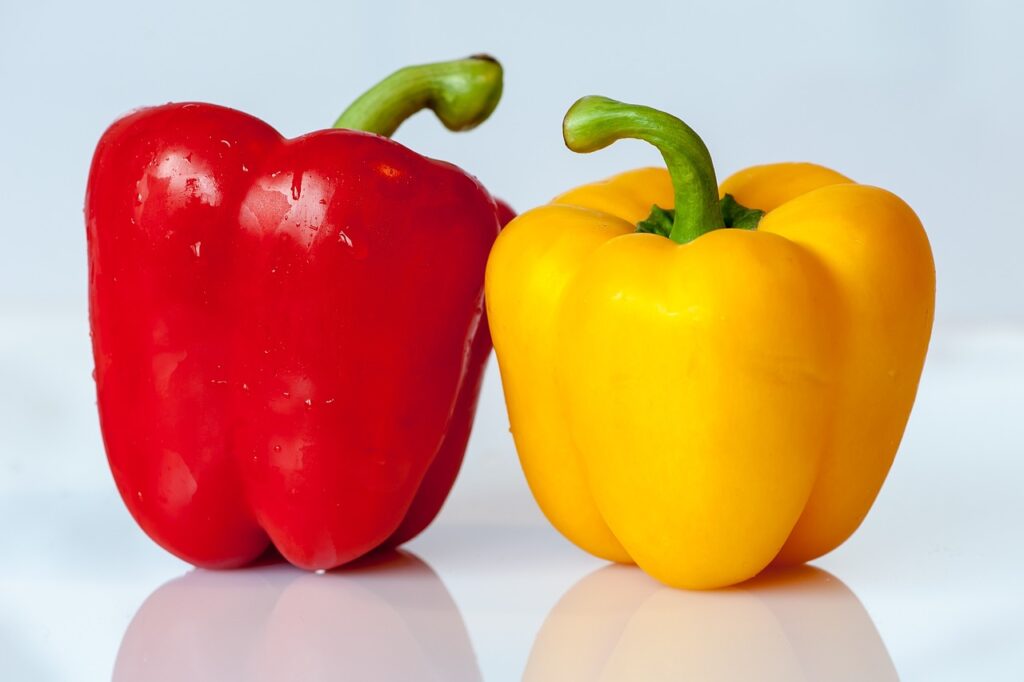The Colorful World of Bell Peppers: A Rainbow of Flavor and Nutrition
Bell peppers, known for their vibrant colors and crisp texture, are a staple in cuisines around the world. From the sun-drenched fields of Spain to the fertile lands of the Netherlands, these versatile vegetables bring both flavor and nutrition to countless dishes. In this post, we’ll explore the fascinating world of bell peppers, diving into their varieties, nutritional benefits, culinary uses, and their journey from farm to table.
A Spectrum of Colors
Bell peppers come in a rainbow of colors, each with its unique flavor profile:
- Green Peppers:
- The unripe version of red peppers
- Slightly bitter and less sweet
- Longest shelf life among all colors
- Red Peppers:
- Fully ripe, sweetest, and most nutrient-dense
- Rich, fruity flavor
- Highest in vitamins A and C
- Yellow Peppers:
- Sweet and tangy flavor
- High in antioxidants
- Often used for their bright color in dishes
- Orange Peppers:
- Sweet with a hint of tanginess
- Rich in beta-carotene
- Adds a sunny hue to meals
- Purple Peppers:
- Less common variety
- Slightly bitter, similar to green peppers
- Rich in anthocyanins, powerful antioxidants
Nutritional Powerhouse
Bell peppers are packed with essential nutrients:
- Vitamin C: One medium-sized red bell pepper contains more than 200% of the daily recommended intake of vitamin C.
- Vitamin A: Particularly high in red peppers, crucial for eye health and immune function.
- Vitamin B6: Important for brain development and function.
- Folate: Essential for cell growth and DNA formation.
- Antioxidants: Including carotenoids and flavonoids, which may help prevent chronic diseases.
- Fiber: Aids in digestion and promotes feelings of fullness.
- Low in Calories: An excellent choice for weight-conscious consumers.
Culinary Uses
Bell peppers are incredibly versatile in the kitchen:
- Raw: Sliced in salads, used as crudités, or as a healthy snack.
- Roasted: Brings out their natural sweetness, perfect for antipasti or as a side dish.
- Stuffed: A classic preparation, filled with meat, rice, or vegetables.
- Grilled: Adds a smoky flavor, great for summer barbecues.
- Sautéed: Common in stir-fries and fajitas.
- Pureed: Used in soups, sauces, and dips.
- Pickled: Preserves the peppers and adds a tangy flavor to dishes.
Growing and Sourcing
Bell peppers thrive in warm, sunny climates. Moon Keks sources its peppers from several key regions:
- Spain: One of the largest producers in Europe, known for high-quality peppers grown in Almería and Murcia.
- Netherlands: A leader in greenhouse cultivation, producing peppers year-round with advanced hydroponic systems.
- Italy: Particularly known for sweet peppers from regions like Sicily and Campania.
- Greece: Produces flavorful peppers, especially in regions like Crete and Peloponnese.
- Turkey: A significant producer, with peppers grown in both open fields and greenhouses.
Seasonal Availability
While greenhouse cultivation allows for year-round production, natural growing seasons affect quality and price:
- Peak Season: Summer to early fall (July to October)
- Off-Season: Winter to early spring (December to April)
During off-season, reliance on greenhouse-grown peppers or imports from warmer climates increases.
Storage and Handling
Proper storage is crucial for maintaining freshness:
- Temperature: Ideal storage temperature is around 7-10°C (45-50°F).
- Humidity: Best kept at 90-95% relative humidity.
- Ethylene Sensitivity: Keep away from ethylene-producing fruits like apples and tomatoes.
- Shelf Life: Varies by color – green peppers last longest (2-3 weeks), while ripe colors last about 1-2 weeks.
Trends in Bell Pepper Consumption
- Snack-Sized Peppers: Growing popularity of mini sweet peppers for convenient, healthy snacking.
- Organic Demand: Increasing consumer preference for organically grown peppers.
- Value-Added Products: Pre-cut pepper strips or pepper-based dips for convenience.
- Colored Pepper Mixes: Growing demand for packages containing a mix of different colored peppers.
- Sustainability Focus: Consumers showing interest in locally grown or sustainably produced peppers.
Culinary Trends
Chefs and food enthusiasts are finding creative ways to use bell peppers:
- Fermented Pepper Sauces: Adding depth to dishes with complex, tangy flavors.
- Pepper-Based Desserts: Innovative chefs incorporating sweet peppers into desserts like sorbets or panna cotta.
- Smoked Peppers: Adding smoky flavors to various dishes, beyond traditional paprika.
- Pepper Powders: Dehydrated and ground peppers used as natural food colorings and flavor enhancers.
- Pepper-Infused Oils: Adding subtle pepper flavors to dressings and marinades.
Challenges in Distribution
- Temperature Control: Maintaining optimal temperature throughout the supply chain to preserve freshness.
- Handling Sensitivity: Peppers are prone to bruising and require careful handling.
- Ripening Management: Controlling ripening process, especially for peppers harvested green.
- Seasonal Fluctuations: Managing supply and demand variations between peak and off-seasons.
- Quality Consistency: Ensuring consistent quality across different sources and seasons.
Future Outlook
The bell pepper industry continues to evolve:
- New Varieties: Development of peppers with enhanced flavors, colors, or nutritional profiles.
- Sustainable Packaging: Increasing use of eco-friendly packaging materials.
- Vertical Farming: Potential for year-round, local production in urban areas.
- Precision Agriculture: Use of AI and IoT for optimized pepper cultivation.
- Nutraceutical Applications: Exploring the use of pepper extracts in health supplements.
Bell peppers are more than just a colorful addition to our plates; they’re a nutritional powerhouse with incredible versatility in the kitchen. For distributors like Moon Keks, understanding the nuances of bell pepper varieties, their nutritional benefits, and the latest trends in consumption and cultivation is key to meeting consumer demands. As we continue to appreciate the vibrant flavors and health benefits of bell peppers, the industry will undoubtedly see further innovations in cultivation, distribution, and culinary applications. Whether enjoyed raw in a crisp salad or roasted to sweet perfection, bell peppers remain a beloved vegetable in kitchens around the world.





